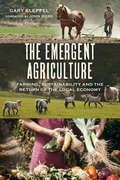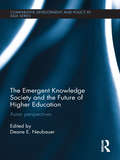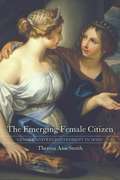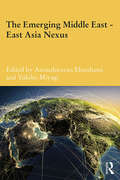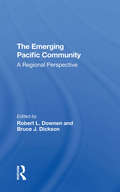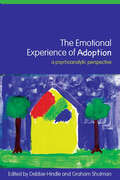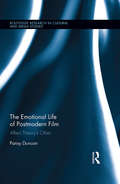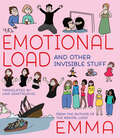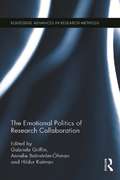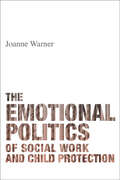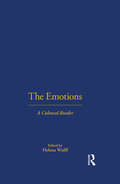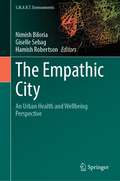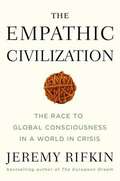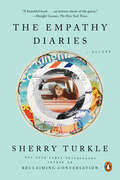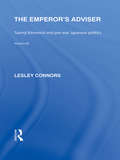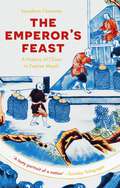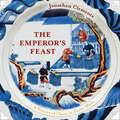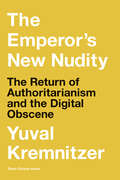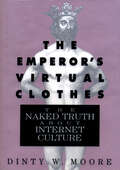- Table View
- List View
The Emergent Agriculture
by Gary Kleppel John IkerdLong embraced by corporations who are driven only by the desire for profit, industrial agriculture wastes precious resources and spews millions of tons of greenhouse gases into the atmosphere each year, exacerbating climate change and threatening the very earth and water on which we depend. However, this dominant system, from which Americans obtain most of their food, is being slowly supplanted by a new paradigm.The Emergent Agriculture is a collection of fourteen thematic essays on sustainability viewed through the lens of farming. Arguing that industrial food production is incompatible with the realities of nature, science, and ethics, this lyrical narrative makes the case for a locally based food system which is: Stable in the face of economic uncertainty Resilient in the face of environmental variability Grounded in stewardship of the land, on attaching value to food and the craft involved in producing it, and on respecting the dignity of farmers, consumer,s and livestockA revolution in food production is underway. Written from the vantage point of an ecologist who is also a farmer, The Emergent Agriculture is essential reading for anyone interested in food security and the potential for growing local economies. Food for thought about the future of food.Gary Kleppel is a professor of biology at the SUNY Albany, where he focuses on sustainable agriculture, conservation-based grazing, and the ecology of human-dominated landscapes. He and his wife Pam are owners of Longfield Farm, where they produce grass-fed lamb, wool, free range chickens and eggs, and artisanal breads.
The Emergent Knowledge Society and the Future of Higher Education: Asian Perspectives (Comparative Development and Policy in Asia)
by Deane E. NeubauerThe nature of higher education is by no means fixed: it has evolved over time; different models of higher education co-exist alongside each other at present; and, worldwide, there are demands for higher education to change to better help support economic growth and to better fit chagning social and economic circumstances. This book examines, from an Asian perspective, the debates about how higher education should change. It considers questions of funding, and of who will attend universities, and the fundamental question of what universities are for, especially as the three key funcations of universities - knowledge creation through research, knowledge dissemination through teaching and service, and knowledge conservation through libraries, the disciplinary structuring of knowledge and in other ways - are increasingly being carried out much more widely outside universities in the new "knowledge society". Throughout, the book discusses the extent to which the countries of East Asia are developing new models of higher education, thereby better preparing themselves for the "new "knowledge society", rather than simply following old Western models.
The Emerging Female Citizen: Gender and Enlightenment in Spain
by Theresa Ann SmithAn important study of women and their roles in society during the 18th-century Spanish Enlightenment.
The Emerging Middle East-East Asia Nexus (Durham Modern Middle East and Islamic World Series)
by Anoushiravan Ehteshami Yukiko MiyagiAs the economies of East Asia grow ever stronger, their need for energy resources increases, which in turn compels closer relations with the countries of the Middle East. This book examines the developing relations between the countries of East Asia, especially China and Japan, with the countries of the Middle East. It looks at various key bilateral relationships, including with Iran and Syria, discusses the impact on the United States’ hegemony in both regions, considers whether the new relations represent a contribution to, or a threat to, peace and stability, and assesses the implications of the changes for patterns of regional and global international relations systems.
The Emerging Pacific Community: A
by Bruce J. Dickson Robert L DownenAs the nations of the Pacific Ocean region experience rapid economic growth, they have begun to recognize the vast potential benefits of regional interdependence. Recent threats of economic nationalism, according to many specialists, have only strengthened the need for organized regional cooperation. The relative success of the Association of South
The Emerging South
by Thomas D. Clark“In 1961 when I entitled this book The Emerging South I realized, of course, that it could not be said positively that the South had emerged to the extent that its efforts in most categories equaled the national achievement. I meant nevertheless to express the belief that the region was undergoing enormous change and that much of the change promised to be for the better. In the passage of three-quarters of a decade, several aspects of modern southern development have come more fully into focus. For better or worse, the South in the years since 1945 has lost many of its traditional regional characteristics. In the field of economic change, there has been marked advancement. More and more the regional thrust has become that of industrial and commercial America in general. The South has been engaged in a relentless crusade to claim a greater share of the national industry, and to raise the level of personal incomes. This is gradually accomplishing. By 1961 it was self-evident that the old southern agricultural system of the yeoman farmer had all but vanished. There remained islands where men still struggled in their clumsy and inefficient way to survive socially and economically. They, however, carried on a losing battle. Toward the close of the decade, it was clear that much southern farming had become a capital business. Farms continued to grow in size and become more highly mechanized. Never in the history of the region was so little human energy engaged in crop production. By the same token, there was never so much human displacement in the South from the old areas of employment. There are reasons to share the views of the 1967 study of the Twentieth Century Fund that the South has gained much momentum. The region has emerged from many of the dark recesses of its past, and it promises to revise its history further in the immediate future."
The Emigrant Communities of Latvia: National Identity, Transnational Belonging, and Diaspora Politics (IMISCOE Research Series)
by Rita Kaša Inta MieriņaThis open access volume examines experiences of contemporary Latvian migrants, thereby focusing on reasons for emigration, processes of integration in their host countries, and – in the case of return migration - re-integration in their home country. In the context of European migration, the book describes the case of Latvia, which is interesting due to the multiple waves of excessive emigration, continuously high migration potential among European Union member states, and diverse migrant characteristics. It provides a fascinating insight into the social and psychological aspects linked to migration in a comparative context. The data in this volume is rich in providing individual level perspectives of contemporary Latvian migrants by addressing issues such as emigrants’ economic, social and cultural inclusion in the host country, ties with the home country and culture, interaction with public authorities both in the host and home country, political views, and perspectives on the permanent settlement in migration or return. Through topics such as assimilation of children, relationships between emigrants representing different emigration waves, the complex identities and attachments of minority emigrants, and the role of culture and media in identity formation and presentation, this book addresses topics that any contemporary emigrant community is faced with.
The Emotional Experience of Adoption: A Psychoanalytic Perspective
by Debbie Hindle Graham ShulmanAdoption is an extremely complex and emotionally demanding process for all those involved. This book explores the emotional experience of adoption from a psychoanalytic perspective, and demonstrates how psychoanalytic understanding and treatment can contribute to thinking about and working with adopted children and their families. Drawing on psychoanalytic, attachment and child development theory, and detailed in-depth clinical case discussion, The Emotional Experience of Adoption explores issues such as: the emotional experience of children placed for adoption, and how this both shapes and is shaped by unconscious processes in the child’s inner world how psychoanalytic child psychotherapy can help as a distinctive source of understanding and as a treatment for children who are either in the process of being adopted or already adopted how such understanding can inform planning and decision making amongst professionals and carers. The Emotional Experience of Adoption explains and accounts for the emotional and psychological complexities involved for child, parents and professionals in adoption. It will be of interest and relevance to anyone involved at a personal level in the adoption process or professionals working in the fields of adoption, social work, child mental health, foster care and family support.
The Emotional Life of Postmodern Film: Affect Theory's Other (Routledge Research in Cultural and Media Studies)
by Pansy DuncanEmotion and Postmodernism: is it possible to imagine an odder couple, stranger bedfellows, less bad company? The Emotional Life of Postmodern Film brings this unlikely pair into sustained dialogue, arguing that the interdisciplinary body of scholarship currently emerging under the rubric of "affect theory" may be unexpectedly enriched by an encounter with the field that has become its critical other. Across a series of radical re-reappraisals of canonical postmodern texts, from Fredric Jameson's Postmodernism to David Cronenberg's Crash, Duncan shows that the same postmodern archive that has proven resistant to strongly subject-based and object-oriented emotions, like anger and sadness, proves all too congenial to a series of idiosyncratic, borderline emotions, from knowingness, fascination and bewilderment to boredom and euphoria. The analysis of these emotions, in turn, promises to shake up scholarly consensus on two key counts. On the one hand, it will restructure our sense of the place and role of emotion in a critical enterprise that has long cast it as the stodgy, subjective sister of a supposedly more critically interesting and politically productive affect. On the other, it will transform our perception of postmodernism as a now-historical aesthetic and theoretical moment, teaching us to acknowledge more explicitly and to name more clearly the emotional life that energizes it.
The Emotional Load: And Other Invisible Stuff
by EmmaThe author of The Mental Load returns with more "visual essays which are transformative agents of change."After the success of The Mental Load, Emma continues in her new book to tangle with issues pertinent to women's experiences, from consent to the "power of love," from the care and attentiveness that women place on others' wellbeing and social cohesion, and how it constitutes another burden on women, to contraception, to the true nature of gallantry, from the culture of rape to diets, from safety in public spaces to retirement, along with social issues such as police violence, women's rights, and green capitalism. And, once more, she hits the mark.
The Emotional Politics of Racism: How Feelings Trump Facts in an Era of Colorblindness
by Paula IoanideWith stop-and-frisk laws, new immigration policies, and cuts to social welfare programs, majorities in the United States have increasingly supported intensified forms of punishment and marginalization against black, Latino, Arab and Muslim people in the United States, even as a majority of citizens claim to support "colorblindness" and racial equality. With this book, Paula Ioanide examines how emotion has prominently figured into these contemporary expressions of racial discrimination and violence. How U. S. publics dominantly feel about crime, terrorism, welfare, and immigration often seems to trump whatever facts and evidence say about these politicized matters. Though four case studies--the police brutality case of Abner Louima; the exposure of torture at Abu Ghraib; the demolition of New Orleans public housing units following Hurricane Katrina; and a proposed municipal ordinance to deny housing to undocumented immigrants in Escondido, CA--Ioanide shows how racial fears are perpetuated, and how these widespread fears have played a central role in justifying the expansion of our military and prison system and the ongoing divestment from social welfare. But Ioanide also argues that within each of these cases there is opportunity for new mobilizations, for ethical witnessing: we must also popularize desires for justice and increase people's receptivity to the testimonies of the oppressed by reorganizing embodied and unconscious structures of feeling.
The Emotional Politics of Research Collaboration (Routledge Advances in Research Methods #7)
by Gabriele Griffin Annelie Bränström-Öhman Hildur KalmanResearch collaboration in the form of networks, projects and centers has become one of the dominant modes of engaging in research, especially funded research, across all academic domains. However, there has been little research on the processes of such collaborations, particularly their affective dimensions. These, as this volume demonstrates and as researchers know well, are highly important, yet mostly not directly engaged with when scientists work together, even though they are experienced by everybody involved. This volume is the first to consider questions such as how the naming of projects impacts on their accompanying "affect-scapes," the policing or disciplining of emotions in research collaborations, their accompanying tensions and how these might be managed, and the challenges to trust between scientists that such collaborations present. Drawing on theories of affect and literature on collaboration, as well as on the contributors’ experiences of being involved in large-scale research projects, the volume also importantly deals directly with some of the key emotions that occur during research collaborations such as blame, elation, frustration, alienation and belonging, and suggests some ways in which one might engage productively with the affective dimensions of research collaboration.
The Emotional Politics of Social Work and Child Protection
by Joanne WarnerFor several decades, social work and child protection systems have been subject to accelerating cycles of crisis and reform, with each crisis involving intense media and political scrutiny. In understanding the nature and causes of this cycle, little attention has been paid to the importance of collective emotions. Using a range of cases from the UK, and also considering cases from the Netherlands, the US and New Zealand, this book introduces the concept of emotional politics. It shows how collective emotions, such as anger, shame, fear and disgust, are central to constructions of risk and blame, and are generated and reflected by official documents, politicians and the media. The book considers strategies for challenging these ‘emotional politics’, including identifying models for a more politically engaged stance for the social work profession.
The Emotions: A Cultural Reader
by Helena WulffEmotions are a loaded topic. From love and hate to grief, fear and envy, emotions are increasingly understood as driving forces in social life. The Emotions: A Cultural Reader applies a cross-cultural perspective on emotions. It examines the fact that emotions are socially and culturally constructed, while highlighting problems of comparison and translation of local terms and emotional experiences. Are emotions cultural or universal? To what extent are there culturally distinct emotions? The Emotions closes the traditional Western gap where emotions are separated from rationality and thought: the heart versus mind debate. By presenting both classic essays and new cutting-edge chapters from anthropology, sociology and psychology with important contributions from philosophy and neuroscience, the volume connects a rich range of cross-cultural studies to form a thriving interdisciplinary debate on emotions.
The Empathic City: An Urban Health and Wellbeing Perspective (S.M.A.R.T. Environments)
by Nimish Biloria Giselle Sebag Hamish RobertsonThis book has a primary focus on inclusions for solutions to problems and not just more on the nature of the current and emerging problems that most other competing titles present. The book is also a true global representation of challenges and opportunities that have been encountered, addressed, and critiqued from a wide variety of contributors rather than academicians per se. In doing so, rather than focusing on techno-centric prowess and associated case studies of the west (as is the case in most competing titles), the book also equally emphasizes upon the vulnerabilities and mitigating solutions being developed and tested in the under-developed and developing nations. Besides this, the book also acquires an ‘Equity’ oriented focus and hints upon sustainable, inclusive modes of shaping our built environment throughout the contributing chapters. The book is also unique in the way it combines the chosen themes to provide a holistic coverage of the broader determinants of urban health and wellbeing, thus being better positioned to address SDG3 within one compact volume. The book also differs from a typical conference proceeding or a non-peer reviewed book since the book’s highly theme specific approach is curated by a scientific peer review committee to carefully maintain diversity of contributions to the book. Cities have a profound power to support or hinder human health and wellbeing in countless ways. Achieving greater health equity has emerged in recent years as a key priority and consideration when designing cities to promote health and wellbeing, although there is a dearth of evidence and practical examples of research translation to guide cities and communities. The book accordingly exemplifies a pluralistic approach to achieving urban health equity which recognises and addresses critical aspects of geography, age, race, background, socioeconomic status, disability, gender etc. With interdisciplinary science clearly pointing to the role of the neighbourhood environment as one of the most important health determinants, this book will undoubtedly lead the next generation of urban health actors to build contextually responsive, equitable, empathic cities to benefit residents around the world. The book, rather than being focused purely on academic propositions for building equitable cities, offers a unique multi-stakeholder perspective by collaborating with the International Society for Urban Health’s 18th International Conference on Urban Health. This unique collaboration allows access to hundreds of scientists, architects, urbanists, multilaterals, policymakers, non-profit leaders, and grassroots organizers. The book captures the voices and concerns of such diverse cross-sectoral professionals and showcases findings that turn evidence into action and impact in communities around the world.Chapter 14 is available open access under a Creative Commons Attribution 4.0 International License via link.springer.com.
The Empathic Civilization
by Jeremy RifkinIn this sweeping new interpretation of the history of civilization, bestselling author Jeremy Rifkin looks at the evolution of empathy and the profound ways that it has shaped our development-and is likely to determine our fate as a species. Today we face unparalleled challenges in an energy-intensive and interconnected world that will demand an unprecedented level of mutual understanding among diverse peoples and nations. Do we have the capacity and collective will to come together in a way that will enable us to cope with the great challenges of our time? In this remarkable book Jeremy Rifkin tells the dramatic story of the extension of human empathy from the rise of the first great theological civilizations, to the ideological age that dominated the 18th and 19th centuries, the psychological era that characterized much of the 20th century and the emerging dramaturgical period of the 21st century. The result is a new social tapestry-The Empathic Civilization-woven from a wide range of fields. Rifkin argues that at the very core of the human story is the paradoxical relationship between empathy and entropy. At various times in history new energy regimes have converged with new communication revolutions, creating ever more complex societies that heightened empathic sensitivity and expanded human consciousness. But these increasingly complicated milieus require extensive energy use and speed us toward resource depletion. The irony is that our growing empathic awareness has been made possible by an ever-greater consumption of the Earth's resources, resulting in a dramatic deterioration of the health of the planet. If we are to avert a catastrophic destruction of the Earth's ecosystems, the collapse of the global economy and the possible extinction of the human race, we will need to change human consciousness itself-and in less than a generation. Rifkin challenges us to address what may be the most important question facing humanity today: Can we achieve global empathy in time to avoid the collapse of civilization and save the planet? One of the most popular social thinkers of our time, Jeremy Rifkin is the bestselling author of The European Dream, The Hydrogen Economy¸ The End of Work, The Biotech Century, and The Age of Access. He is the president of the Foundation on Economic Trends in Washington, D. C.
The Empathic Civilization: The Race to Global Consciousness in a World in Crisis
by Jeremy Rifkin"One of the leading big-picture thinkers of our day" (Utne Reader) delivers his boldest work in this erudite, tough-minded, and far-reaching manifesto. Never has the world seemed so completely united-in the form of communication, commerce, and culture-and so savagely torn apart-in the form of war, financial meltdown, global warming, and even the migration of diseases. No matter how much we put our minds to the task of meeting the challenges of a rapidly globalizing world, the human race seems to continually come up short, unable to muster the collective mental resources to truly "think globally and act locally." In his most ambitious book to date, bestselling social critic Jeremy Rifkin shows that this disconnect between our vision for the world and our ability to realize that vision lies in the current state of human consciousness. The very way our brains are structured disposes us to a way of feeling, thinking, and acting in the world that is no longer entirely relevant to the new environments we have created for ourselves. The human-made environment is rapidly morphing into a global space, yet our existing modes of consciousness are structured for earlier eras of history, which are just as quickly fading away. Humanity, Rifkin argues, finds itself on the cusp of its greatest experiment to date: refashioning human consciousness so that human beings can mutually live and flourish in the new globalizing society. In essence, this shift in consciousness is based upon reaching out to others. But to resist this change in human relations and modes of thinking, Rifkin contends, would spell ineptness and disaster in facing the new challenges around us. As the forces of globalization accelerate, deepen, and become ever more complex, the older faith-based and rational forms of consciousness are likely to become stressed, and even dangerous, as they attempt to navigate a world increasingly beyond their reach and control. Indeed, the emergence of this empathetic consciousness has implications for the future that will likely be as profound and far-reaching as when Enlightenment philosophers upended faith-based consciousness with the canon of reason.
The Empathy Diaries: A Memoir
by Sherry TurkleMIT psychologist and bestselling author of RECLAIMING CONVERSATION and ALONE TOGETHER, Sherry Turkle's intimate memoir of love and work <P><P> For decades, Sherry Turkle has shown how we remake ourselves in the mirror of our machines. Here, she illuminates our present search for authentic connection in a time of uncharted challenges. Turkle has spent a career composing an intimate ethnography of our digital world; now, marked by insight, humility, and compassion, we have her own. <P><P> In this vivid and poignant narrative, Turkle ties together her coming-of-age and her pathbreaking research on technology, empathy, and ethics. Growing up in postwar Brooklyn, Turkle searched for clues to her identity in a house filled with mysteries. She mastered the codes that governed her mother's secretive life. She learned never to ask about her absent scientist father--and never to use his name, her name. Before empathy became a way to find connection, it was her strategy for survival. <P><P> Turkle's intellect and curiosity brought her to worlds on the threshold of change. She learned friendship at a Harvard-Radcliffe on the cusp of coeducation during the antiwar movement, she mourned the loss of her mother in Paris as students returned from the 1968 barricades, and she followed her ambition while fighting for her place as a woman and a humanist at MIT. There, Turkle found turbulent love and chronicled the wonders of the new computer culture, even as she warned of its threat to our most essential human connections. The Empathy Diaries captures all this in rich detail--and offers a master class in finding meaning through a life's work.
The Emperor of All Maladies: A Biography of Cancer
by Siddhartha MukherjeeWINNER OF THE PULITZER PRIZEThe Emperor of All Maladies is a magnificent, profoundly humane "biography" of cancer--from its first documented appearances thousands of years ago through the epic battles in the twentieth century to cure, control, and conquer it to a radical new understanding of its essence. Physician, researcher, and award-winning science writer, Siddhartha Mukherjee examines cancer with a cellular biologist's precision, a historian's perspective, and a biographer's passion. The result is an astonishingly lucid and eloquent chronicle of a disease humans have lived with--and perished from--for more than five thousand years. The story of cancer is a story of human ingenuity, resilience, and perseverance, but also of hubris, paternalism, and misperception. Mukherjee recounts centuries of discoveries, setbacks, victories, and deaths, told through the eyes of his predecessors and peers, training their wits against an infinitely resourceful adversary that, just three decades ago, was thought to be easily vanquished in an all-out "war against cancer." The book reads like a literary thriller with cancer as the protagonist. From the Persian Queen Atossa, whose Greek slave may have cut off her diseased breast, to the nineteenth-century recipients of primitive radiation and chemotherapy to Mukherjee's own leukemia patient, Carla, The Emperor of All Maladies is about the people who have soldiered through fiercely demanding regimens in order to survive--and to increase our understanding of this iconic disease. Riveting, urgent, and surprising, The Emperor of All Maladies provides a fascinating glimpse into the future of cancer treatments. It is an illuminating book that provides hope and clarity to those seeking to demystify cancer.
The Emperor's Adviser: Saionji Kinmochi and Pre-War Japanese Politics (Routledge Library Editions: Japan)
by Lesley ConnorsSaionji Kinmochi was an aristocrat, a scholar and a progressive liberal politician who twice occupied the highest political office in the nation and who, during three decades, as adviser to three Emperors, coordinated and directed Japanese politics. His long life encompassed the emergence of the modern Japanese state, the establishment of the constitution, the integration of Japan into the inter-war, international community and the creation, and subsequent erosion of the democratic process. The story of his twilight years chronicles the conflicts between the goals of liberalism and internationalism which dominated Japanese politics in the 1920s and the right-wing militarism which held sway in the years leading to the Pacific War. He was a central figure in the turbulent, formative period of Japan’s political ideology.
The Emperor's Feast: 'A tasty portrait of a nation' –Sunday Telegraph
by Jonathan Clements'A galloping journey through thousands of years of Chinese culinary history . . . a timely reminder that the country's modern cuisine is the delicious fruit of a rich, ancient and perhaps surprisingly multicultural tradition' FUCHSIA DUNLOP, SPECTATOR'A tasty portrait of a nation' SUNDAY TELEGRAPH'A splendid introduction to the complex history of China' GUARDIAN'A terrific read . . . Jonathan Clements writes with erudition and humour' DAILY MAIL'This book is itself a feast, each chapter a sumptuous course'Frederik L. Schodt, author of My Heart Sutra'Witty and insightful' Derek Sandhaus, author of Drunk in China****************The history of China - not according to emperors or battles, but according to its food and drink.The Emperor's Feast is the epic story of a nation and a people, told through one of its most fundamental pillars and successful exports: food. Following the journeys of different ingredients, dishes and eating habits over 5,000 years of history, author and presenter Jonathan Clements examines how China's political, cultural and technological evolution and her remarkable entrance onto the world stage have impacted how the Chinese - and the rest of the world - eat, drink and cook.We see the influence of invaders such as the Mongols and the Manchus, and discover how food - like the fiery cuisine of Sichuan or the hardy dishes of the north - often became a stand-in for regional and national identities. We also follow Chinese flavours to the shores of Europe and America, where enterprising chefs and home cooks created new traditions and dishes unheard of in the homeland.From dim sum to mooncakes to General Tso's chicken, The Emperor's Feast shows us that the story of Chinese food is ultimately the story of a nation: not just the one that history tells us, but also the one that China tells us about itself.
The Emperor's Feast: 'A tasty portrait of a nation' –Sunday Telegraph
by Jonathan Clements'A galloping journey through thousands of years of Chinese culinary history . . . a timely reminder that the country's modern cuisine is the delicious fruit of a rich, ancient and perhaps surprisingly multicultural tradition' FUCHSIA DUNLOP, SPECTATOR'A tasty portrait of a nation' SUNDAY TELEGRAPH'A splendid introduction to the complex history of China' GUARDIAN'A terrific read . . . Jonathan Clements writes with erudition and humour' DAILY MAIL'This book is itself a feast, each chapter a sumptuous course'Frederik L. Schodt, author of My Heart Sutra'Witty and insightful' Derek Sandhaus, author of Drunk in China****************The history of China - not according to emperors or battles, but according to its food and drink.The Emperor's Feast is the epic story of a nation and a people, told through one of its most fundamental pillars and successful exports: food. Following the journeys of different ingredients, dishes and eating habits over 5,000 years of history, author and presenter Jonathan Clements examines how China's political, cultural and technological evolution and her remarkable entrance onto the world stage have impacted how the Chinese - and the rest of the world - eat, drink and cook.We see the influence of invaders such as the Mongols and the Manchus, and discover how food - like the fiery cuisine of Sichuan or the hardy dishes of the north - often became a stand-in for regional and national identities. We also follow Chinese flavours to the shores of Europe and America, where enterprising chefs and home cooks created new traditions and dishes unheard of in the homeland.From dim sum to mooncakes to General Tso's chicken, The Emperor's Feast shows us that the story of Chinese food is ultimately the story of a nation: not just the one that history tells us, but also the one that China tells us about itself.
The Emperor's Feast: 'A tasty portrait of a nation' –Sunday Telegraph
by Jonathan ClementsThe journey of Chinese food over 5,000 years of history - and the story it tells us about the land and its people.From the humble takeaway in the middle of a tiny English village to the embarrassment of riches offered in a big-city Chinatown, Chinese food is everywhere to be found. But the meals on offer merely scratch the surface of a rich and dizzyingly varied culinary tradition, spread across 5,000 years of history and over the more than thirty provinces and regions that constitute modern China - not to mention the Chinese diaspora communities all across the world.In The Emperor's Feast, author and TV presenter Dr Jonathan Clements invites us into the history of Chinese food, starting with the earliest grain stews and the rudimentary chopsticks of the Bronze Age and taking us through the development of dining etiquette under Confucius, the popularisation of rice and the dawn of the dumpling in the 4th century. We see how Chinese cuisine morphed and adapted to the eating habits of invaders such as the Mongols and the Manchus, and how food - like the heady, fiery cuisine of Sichuan or the hardy wheat-based dishes of the north - often became a stand-in for Chinese regional and national identities. Dr Clements then traces the journey of Chinese food to our modern Chinatowns and takeaways, from the tumultuous early days of the 19th century to the profound impact of the rapid industrialisation and globalisation of post-Mao China on the national diet. As we enter the 21st century with food scandals and a Guinness World Record attempt involving fried rice, The Emperor's Feast shows us that the story of Chinese food is inextricably entwined with the story of China: not only the one that history tells us, but also the one that China tells about itself.(P) 2021 Hodder & Stoughton Ltd
The Emperor's New Nudity: The Return of Authoritarianism and the Digital Obscene (Short Circuits)
by Yuval KremnitzerAn analysis of contemporary authoritarianism and the medium in which it flourishes, the internet, as well as what lies at the complex intersection of authority and technology.In recent decades, a new style of authoritarian politics has taken hold throughout the liberal-democratic world. The new authority figures are characterized by obscene, transgressive behavior, reminiscent of the &“crowd&” leader as theorized by Freud, only far less transient. In The Emperor's New Nudity, Yuval Kremnitzer considers the fraught intersection of authority and technology—the internet being the medium that has allowed contemporary authoritarianism to thrive—asking foundational questions such as: How can we think of the network as a social phenomenon? What can social and political phenomena teach us about the nature of the new technology? And how does technology reshape the very fabric of social and political life?Technology, Kremnitzer writes, leads us toward an impersonal and hyperrational world to such an extent that it renders human subjectivity outmoded. Authority, on the other hand, anchors our subjective identifications to certain figures and seems to be hopelessly primitive and irrational. What is required, then, is a dialectics of the primal—a study of the way in which what strikes us as essential enters into the dynamics of historical change. From this perspective, authority and technology can be said to be divided by a common object—the unwritten law, and the special knowledge that pertains to it: a knowledge without knowers.
The Emperor's Virtual Clothes: The Naked Truth About Internet Culture
by Dinty W. MooreA skeptic by nature, a writer and teacher more at home with ballpoint pens than computer programs, Dinty W. Moore wanted to find out for himself if the much-touted Internet and the electronic culture it has spawned is really going to be the Next Big Thing, or whether it's the emperor's new clothes. This is not a how-to guide, a giddy net-head's online magical mystery tour, or a binaries-in-the-sky futurist treatise. Instead, this book tells it like it is about the Internet. Anyone who's asked, Who's there? What am I missing? and What is it all about? will find Moore's good-natured skepticism a welcome break from the explosion of wide-eyed techno-hype raging all around us. "Moore is far and away the best pure writer of the 'Wired School.' He's like the Stage Manager poking his head in around the set of 'Our Town.' Funny that it took the arrival of this commonsensical outsider to finally put a real human face on the digital world."--San Jose Mercury-News.
